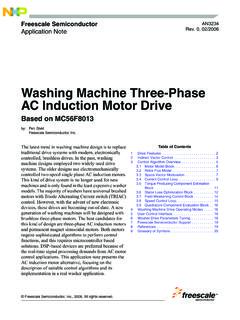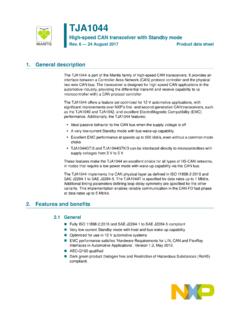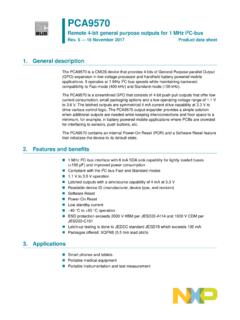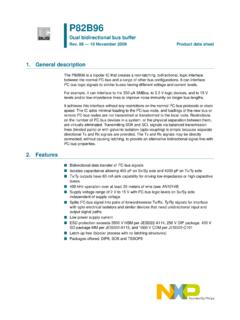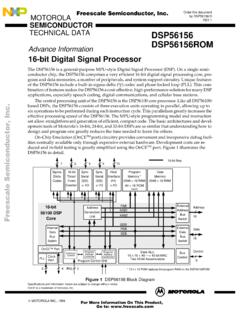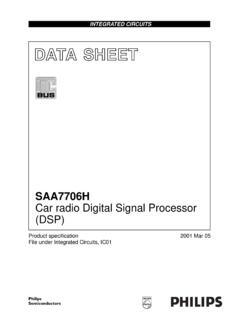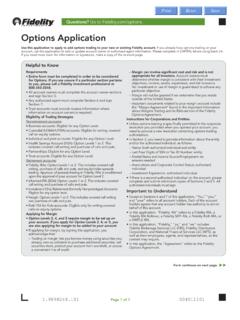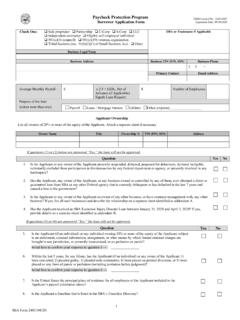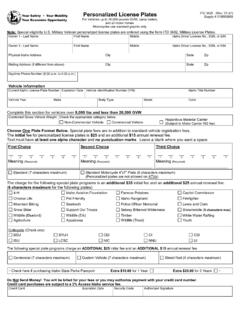Transcription of Crystal Oscillator Troubleshooting Guide
1 Freescale Semiconductor AN3208. Rev. 0, 1/2006. Application Note Crystal Oscillator Troubleshooting Guide by: Sergio Garcia de Alba Garcin RTAC Americas 1 Overview 1. Table of Contents Overview .. 1. This document is a quick-reference Troubleshooting 2 Introduction .. 1. 3 Oscillator Configurations.. 2. Guide for solving Crystal Oscillator problems that might 4 Components in the Colpitts Configuration .. 3. be encountered when working with microcontrollers. 5 Components in the Pierce Configuration .. 3. 6 Crystal Overdriving .. 4. A practical explanation of the Pierce and Colpitts 7 Insufficient Loop Gain .. 5. oscillators used in Freescale microcontrollers and 8 Long Start-Up Time.
2 5. recommendations to help solve common problems with 9 Temperature and Voltage Issues .. 5. microcontroller Crystal oscillators are presented in the 10 Noise Immunity .. 6. 11 Layout Issues .. 6. following sections. Nevertheless, a particular problem 12 Other Problems.. 7. might require a different solution from those proposed in 13 Conclusion .. 7. this application note. Most of the points discussed will 14 References .. 8. help in the design stage to come about with a more reliable Oscillator . 2 Introduction Most microcontrollers can use a Crystal Oscillator as their clock source. Other options include external canned oscillators , resonators, RC oscillators , and internal clocks.
3 The main advantages of a Crystal Oscillator are frequency accuracy, stability, and low power consumption. However, high reliability is needed to fully benefit from these advantages. Freescale Semiconductor, Inc., 2006. All rights reserved. Oscillator Configurations To solve common problems with Crystal oscillators and to achieve high reliability, it is important to pay attention to the configuration used, the components and their values, and the layout. This paper will show how these elements affect such factors as Crystal power dissipation, stability, variations with temperature, feedback strength, start-up time, noise immunity, and thus, reliability and correct operation.
4 It also contains suggestions for solving problems in these areas. 3 Oscillator Configurations The two most common Oscillator configurations for microcontrollers are the Pierce and the Colpitts configurations. The M68HC08 and HCS08 microcontrollers implement the Pierce Oscillator configuration. The MC68HC12 and HCS12 microcontrollers use either a variation of the Colpitts configuration (the translated ground Colpitts configuration) or the Pierce configuration. In some microcontrollers both options are available and it is possible to choose between the two. To select the best option when a choice is possible, it's important to understand the respective advantages of the Pierce and the Colpitts configurations.
5 The two configurations have a similar AC equivalent circuit, but the location of the common ground node differs. Many of the performance differences between these configurations can be attributed to the varying effects of stray reactances as the ground is moved and to the effects of the biasing elements. In the Colpitts configuration stray reactances tend to appear across the Crystal . This degrades performance and reliability, and the effect is worsened by biasing elements in this configuration. In the Pierce configuration, performance and reliability are considerably less affected because stray elements tend to appear across the load capacitors ( , stray capacitance tends to add to the load capacitors, so it's easy to compensate by simply reducing the load capacitors' value).
6 Freescale's Colpitts configuration provides an amplitude limitation control (ALC) loop which permits lower current consumption and lower levels of RF emissions. However, the Pierce configuration is less susceptible to noise, doesn't have a DC voltage across the Crystal , and starts up faster. Unless the lower current consumption of the Colpitts configuration is required, it is highly recommended to opt for the Pierce configuration due to its better reliability. Figure 1. Colpitts Oscillator Crystal Oscillator Troubleshooting Guide , Rev. 0. 2 Freescale Semiconductor Components in the Colpitts Configuration Figure 2. Pierce Oscillator 4 Components in the Colpitts Configuration An important remark with the Colpitts configuration is that it produces a DC voltage across the Crystal .
7 This causes some crystals to age faster, and the specific effect will depend on the Crystal 's manufacturing process. Since this is a long-term reliability issue, problems won't be observed in the initial testing. To solve the problem, a capacitor can be added to block the DC voltage, as shown in Figure 1. Consult the Crystal manufacturer on the value for the capacitor and whether it should be included. If it's impossible to consult with the Crystal manufacturer, it is recommended that you add a capacitor to block the DC voltage. A good rule of thumb is to use a capacitor approximately 100 times the load capacitance of the Crystal .
8 The exact value is not critical, and should be a value around 1 nF. The series combination of C1 and C2: (C1*C2) / (C1+C2), should give a value close to the load capacitance, CL, specified by the Crystal manufacturer. Be sure to consider stray capacitances when performing this calculation. Since the feedback voltage is taken from the voltage divisor made up from C1. and the Crystal , increasing C1 will result in stronger feedback, while reducing its value will result in weaker feedback. Insufficient feedback could prevent oscillation from starting or make oscillation difficult to sustain. In the past, excessive feedback sometimes resulted in Crystal overdrive.
9 Crystal overdrive is very unlikely with modern ICs because they now operate at very low voltages. 5 Components in the Pierce Configuration In general, the smaller the value of RS (Figure 2), the faster the Oscillator will start. RS must be large enough to avoid overdriving the Crystal , yet small enough to provide enough current to start oscillation quickly (an RS that's too large could cause the Oscillator to fail to start). RS can in some cases be zero (shorted), especially with high-frequency crystals. Crystal Oscillator Troubleshooting Guide , Rev. 0. Freescale Semiconductor 3. Crystal Overdriving RB, also known as feedback resistance (Rf) and shown in Figure 2, is used to bias the input of the inverting amplifier.
10 By pulling the input of the amplifier toward the voltage at the output, an unstable condition is created, stimulating oscillation. It can also be observed that feedback resistance affects the loop gain of the amplifier, which is augmented as the value for the feedback resistance is increased. The value for capacitors C1 and C2 must be chosen so that the series combination: (C1*C2) / (C1+C2) gives a value close to the load capacitance, CL, specified by the Crystal manufacturer. Be sure to add stray capacitances in the previous calculation. Occasionally, C1 can be chosen to be slightly smaller than C2 to increase the voltage swing at EXTAL without compromising stability; using a trimmer capacitor in lieu of C1 or C2 can help find the ideal most applications it is recommended to have the same value for C1 and C2.



